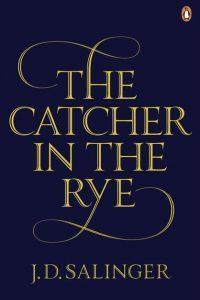“If you really want to hear about it, the first thing you’ll probably want to know is where I was born, and what my lousy childhood was like, and how my parents were occupied and all before they had me, and all that David Copperfield kind of crap, but I don’t feel like going into it, if you want to know the truth.”
The Catcher in the Rye is one of the greatest teenage angst and rebellion tales of all times.
It was first published in serial form in 1945–1946 and then later as a novel in 1951 by J. D. Salinger. It deals with many crucial themes such as alienation, superficiality, and identity. Widely regarded as one of the greatest books ever written, many schools and libraries ban it due to profanity, violence, and disparaging comments about the education system.
Although the novel has never been adapted on screen, it has inspired many famous films and plays. Famous authors have also referenced it as a source of inspiration, such as Plath’s The Bell Jar and Chbosky’s The Perks of Being a Wallflower. It was Salinger’s first-ever novel and by far his greatest.
Summary
It follows 16-year-old Holden Caulfield as he leaves boarding school, travels around New York, and deals with depression, alcohol abuse, and loss of identity. He talks about his future, or lack thereof, calls up old friends and gets in trouble with a pimp. Caulfield struggles to figure out what to do with his life and simultaneously wats to run away yet never leave. He’s a symbol of isolated adolescence everywhere and generation after generation can relate to this confused teenager living in an adult’s world.
Commentary
The Catcher in the Rye never reached the bestseller list when first published. However, it has since been named one of the greatest books of the twentieth century.
Praise
- Both children and adults can relate. The novel was originally intended for adults but has since become a teenage icon. It holds messages for both the young and the old. The youth of today can take it’s rebellion and angst at face value, while the elderly can read into its messages about life. This is one of the very few novels that can genuinely be enjoyed no matter what your age is.
- The protagonist, Holden Caulfield, is incredibly well written. He comes off as a standard moody teenager but has far deeper, emotional thoughts. He’s stubborn, lazy, and immature, but he’s also lonely and untethered. Caulfield’s a character that speaks to each generation as they read the book, no matter what their circumstances are.
- It gives a very real and very honest insight into the teenage mind. Yes, teenagers can be depressed and angsty, and yes, some teenagers aren’t like that at all. But every adolescent has struggled with identity at one stage or another, especially during the awkward phase between childhood and adulthood. Caulfield portrays this perfectly. He’s on the verge of an emotional breakdown, anxious about his future, and worried about how he’ll turn out, just like the majority of today’s youth.
Critique
- The reader’s relationship with Caulfield is very polarising. Either you love him, or you hate him. While most find him relateable, there are some readers who find him irritating. He can be rude, hypocritical and unfeeling. Caulfield’s not a very likeable character and at times he becomes very unlikeable. He thinks everyone else in the world is fake and stupid. He acts dangerously and impulsively and generally causes trouble wherever he goes.
- There is no definite plot. The story isn’t in a traditional act-by-act layout, and there’s no actual turning point in the book. It’s in Caulfield’s point of view and sort of meanders along until the end, which comes suddenly and surprisingly. There is no beginning, middle, and end, and this can throw some readers off.
- Caulfield doesn’t sugarcoat anything and says exactly what he means. While in some cases this is good and even entertaining to read, in others, not so much. He’s very clearly sexist and homophobic and makes disparaging remarks throughout the novel. Every woman he meets he objectifies, describing them as fake, vain, and stupid. He argues with effeminate men and sneers at a potentially gay man. He doesn’t socialise with people who are “lower” than him and sees no problem in having this attitude.
Recommendations
Overall, I’d give J. D. Salinger’s The Catcher in the Rye a four out of five. It’s a ‘love it or hate it’ type of novel that the majority of today’s population love.
I’d recommend this novel to both teenagers and adults alike. It has brilliant messages about identity, age, and life itself and Caulfield is one of the most relatable characters of all time.

Want to read it for yourself?
Prefer to listen instead?
